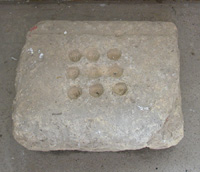 |
 |
 |
 |
 |
 |
 |
|
Byland Abbey: History
Byland Abbey: Buildings
|
The guesthouse Hospitality was an integral part of monastic life and Byland, like other Cistercian houses, made provision for guests within the precinct. At the time of the Dissolution, it was said that of all the religious houses in the North of England, Byland made the greatest contribution to hospitality.(57)
Today, there are no remains of the guest complex at Byland,
but the community would probably have had similar facilities to Fountains,
where the outline
of an aisled guest hall and the standing remains of two guest houses can
still be seen. Whereas more distinguished visitors would have been accommodated
in
the guest houses, those of lesser note would have been provided for in the
hall. Not everyone who visited the abbey would have stayed as a guest, but many would have been refreshed in the guest house, where the abbot presided as host. It is unclear to what extent visitors would have mingled with the monastic community. Whilst official legislation and, indeed, contemporary criticism of the Cistercians’ exclusiveness suggest that there was little interaction between the monks and their guests, specific examples reveal that this was not always so. For instance, the Augustinian Canon, William of Newburgh, describes how he had often heard the colourful reminiscences of an elderly monk, Wimund, when he visited the house. Furthermore, it was at Abbot Roger of Byland’s instigation that William wrote his commentary on the Song of Songs: Your frequent and sacred wishes, Father
Roger, have projected from me, |
